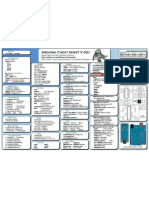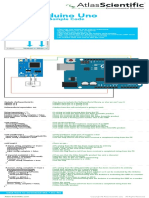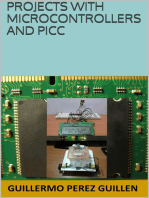Arduino Uno Ec Sample Code
Uploaded by
ພໍ່ ທ້າວ ທະນາກອນArduino Uno Ec Sample Code
Uploaded by
ພໍ່ ທ້າວ ທະນາກອນTM
Arduino Uno
Conductivity Sample Code
//This code was written to be easy to understand.
//Code efficiency was not considered.
//Modify this code as you see fit.
//This code will output data to the Arduino serial monitor.
//Type commands into the Arduino serial monitor to control the EC circuit.
//This code was written in the Arduino 1.6.5 IDE
//An Arduino UNO was used to test this code.
GND
9
8
7
6
5
4
3
2
1
0
AREF
13
12
10
11
RESET
RX0
TX0
DIGITAL (PWM= )
ICSP2
L
TX ON
Arduino
TM
RX
1
ICSP
center
sheild
POWER ANALOG IN
RESET
IOREF
GND
GND
3V3
VIN
5V
A0
A1
A2
A3
A4
A5
BNC
#include <SoftwareSerial.h> //we have to include the SoftwareSerial library, or else we can't use it
#define rx 2 //define what pin rx is going to be
#define tx 3 //define what pin tx is going to be
SoftwareSerial myserial(rx, tx); //define how the soft serial port is going to work
String inputstring = ""; //a string to hold incoming data from the PC
String sensorstring = ""; //a string to hold the data from the Atlas Scientific product
boolean input_string_complete = false; //have we received all the data from the PC
boolean sensor_string_complete = false; //have we received all the data from the Atlas Scientific product
void setup() { //set up the hardware
Serial.begin(9600); //set baud rate for the hardware serial port_0 to 9600
myserial.begin(9600); //set baud rate for the software serial port to 9600
inputstring.reserve(10); //set aside some bytes for receiving data from the PC
sensorstring.reserve(30); //set aside some bytes for receiving data from Atlas Scientific product
}
void serialEvent() { //if the hardware serial port_0 receives a char
inputstring = Serial.readStringUntil(13); //read the string until we see a <CR>
input_string_complete = true; //set the flag used to tell if we have received a completed string from the PC
}
void loop() { //here we go...
if (input_string_complete) { //if a string from the PC has been received in its entirety
myserial.print(inputstring); //send that string to the Atlas Scientific product
myserial.print('\r'); //add a <CR> to the end of the string
inputstring = ""; //clear the string
input_string_complete = false; //reset the flag used to tell if we have received a completed string from the PC
}
if (myserial.available() > 0) { //if we see that the Atlas Scientific product has sent a character
char inchar = (char)myserial.read(); //get the char we just received
sensorstring += inchar; //add the char to the var called sensorstring
if (inchar == '\r') { //if the incoming character is a <CR>
sensor_string_complete = true; //set the flag
}
}
if (sensor_string_complete == true) { //if a string from the Atlas Scientific product has been received in its entirety
if (isdigit(sensorstring[0]) == false) { //if the first character in the string is a digit
Serial.println(sensorstring); //send that string to the PC's serial monitor
}
else //if the first character in the string is NOT a digit
{
print_EC_data(); //then call this function
}
sensorstring = ""; //clear the string
sensor_string_complete = false; //reset the flag used to tell if we have received a completed string from the
} //Atlas Scientific product
}
void print_EC_data(void) { //this function will pars the string
char sensorstring_array[30]; //we make a char array
char *EC; //char pointer used in string parsing
char *TDS; //char pointer used in string parsing
char *SAL; //char pointer used in string parsing
char *GRAV; //char pointer used in string parsing
float f_ec; //used to hold a floating point number that is the EC
sensorstring.toCharArray(sensorstring_array, 30); //convert the string to a char array
EC = strtok(sensorstring_array, ","); //let's pars the array at each comma
TDS = strtok(NULL, ","); //let's pars the array at each comma
SAL = strtok(NULL, ","); //let's pars the array at each comma
GRAV = strtok(NULL, ","); //let's pars the array at each comma
Serial.print("EC:"); //we now print each value we parsed separately
Serial.println(EC); //this is the EC value
Serial.print("TDS:"); //we now print each value we parsed separately
Serial.println(TDS); //this is the TDS value
Serial.print("SAL:"); //we now print each value we parsed separately
Serial.println(SAL); //this is the salinity value
Serial.print("GRAV:"); //we now print each value we parsed separately
Serial.println(GRAV); //this is the specific gravity
Serial.println(); //this just makes the output easier to read
//f_ec= atof(EC); //uncomment this line to convert the char to a float
}
Click here to download the *.ino file
Atlas-Scientific.com Copyright © Atlas Scientific LLC All Rights Reserved
You might also like
- Arduino + Processing - Make A Radar Screen To Visualise Sensor Data From SRF-05 - Part 1: Setting Up The Circuit and Outputting ValuesNo ratings yetArduino + Processing - Make A Radar Screen To Visualise Sensor Data From SRF-05 - Part 1: Setting Up The Circuit and Outputting Values11 pages
- Automated Titration Machine - 5 Steps (With Pictures) - InstructablesNo ratings yetAutomated Titration Machine - 5 Steps (With Pictures) - Instructables4 pages
- IOT ARCHITECTURES and PROTOCOLS Lab Experiments (9)No ratings yetIOT ARCHITECTURES and PROTOCOLS Lab Experiments (9)12 pages
- 4 Port UART Arduino MEGA Sample Code: Revised 7/10/15No ratings yet4 Port UART Arduino MEGA Sample Code: Revised 7/10/151 page
- Elif Avcu - 220 Fun Projects With Arduino (2020)No ratings yetElif Avcu - 220 Fun Projects With Arduino (2020)3,101 pages
- Step 1: Connecting The RFID Module To ArduinoNo ratings yetStep 1: Connecting The RFID Module To Arduino24 pages
- Part-1 PIR Motion Sensor and Servo CodeNo ratings yetPart-1 PIR Motion Sensor and Servo Code15 pages
- 4CS016EmbeddedSystemsWeek5_72862fca-9108-4b53-9a62-6d3964883173_90187_No ratings yet4CS016EmbeddedSystemsWeek5_72862fca-9108-4b53-9a62-6d3964883173_90187_27 pages
- Radar System Using Arduino UNOand Ultrasonic SensorNo ratings yetRadar System Using Arduino UNOand Ultrasonic Sensor12 pages
- Demo 2 How To Use Multiple Serial Ports On Arduino ESP32No ratings yetDemo 2 How To Use Multiple Serial Ports On Arduino ESP322 pages
- Fill Your Glass With Gold-When It's Half-Full or Even Completely ShatteredFrom EverandFill Your Glass With Gold-When It's Half-Full or Even Completely ShatteredNo ratings yet
- DIY Hydroponic Gardens - How To Design - 2No ratings yetDIY Hydroponic Gardens - How To Design - 2514 pages
- Smart Farm: Applying The Use of Nodemcu, Iot, Netpie and Line Api For A Lingzhi Mushroom Farm in ThailandNo ratings yetSmart Farm: Applying The Use of Nodemcu, Iot, Netpie and Line Api For A Lingzhi Mushroom Farm in Thailand8 pages
- 8086/8088 CPU Architecture & Operation - Programming Model, Pins & Signals - Memory Segmentation - Processor Bus Cycle (Timing Diagram)No ratings yet8086/8088 CPU Architecture & Operation - Programming Model, Pins & Signals - Memory Segmentation - Processor Bus Cycle (Timing Diagram)70 pages
- A-Series Richland Ad680Kwoa44Hl A10-6800K 100 4.1Ghz: Processor Core Name Cpu Code Cpu No FSB Cpu SpeedNo ratings yetA-Series Richland Ad680Kwoa44Hl A10-6800K 100 4.1Ghz: Processor Core Name Cpu Code Cpu No FSB Cpu Speed2 pages
- AMBA Based System For High Speed IP ValidationNo ratings yetAMBA Based System For High Speed IP Validation45 pages
- Programming With STM32: Getting Started With The Nucleo Board and C/C++ Donald Norris 2024 Scribd Download100% (5)Programming With STM32: Getting Started With The Nucleo Board and C/C++ Donald Norris 2024 Scribd Download54 pages
- What Were Microsoft's Motives in Entering The Games Console Market With Xbox?No ratings yetWhat Were Microsoft's Motives in Entering The Games Console Market With Xbox?2 pages
- Complete Download (eBook PDF) Engineering Graphics Essentials 5th Edition by Kirstie Plantenberg PDF All Chapters100% (1)Complete Download (eBook PDF) Engineering Graphics Essentials 5th Edition by Kirstie Plantenberg PDF All Chapters51 pages
- Dell EMC PowerEdge R450 Technical GuideNo ratings yetDell EMC PowerEdge R450 Technical Guide48 pages
- The Linux Kernel: Blueprints For World DominationNo ratings yetThe Linux Kernel: Blueprints For World Domination56 pages
- Security Door Controls: Installation Instructions SERIES 1510, 1570, 1580 EMLOCKNo ratings yetSecurity Door Controls: Installation Instructions SERIES 1510, 1570, 1580 EMLOCK4 pages
- Lecture 2-Hardware, Software and Display DevicesNo ratings yetLecture 2-Hardware, Software and Display Devices13 pages

























































































